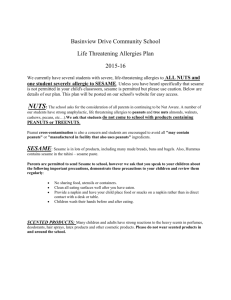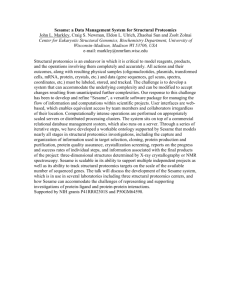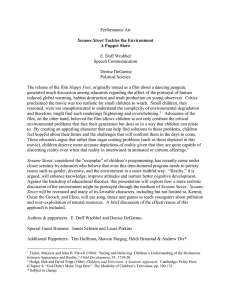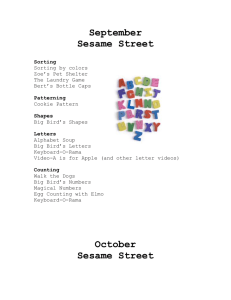IRJET- Assessing the Genuinty of Sesame Oil Available in Markets of India using Bellier Turbidity Temperature Test (BTTT)
advertisement
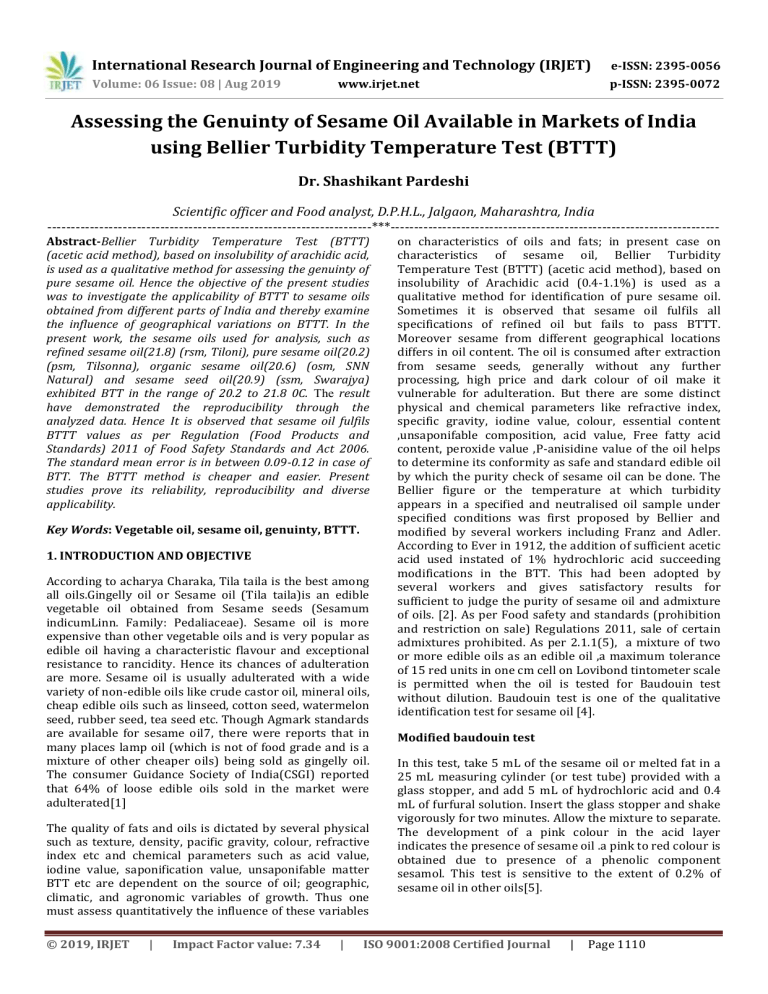
International Research Journal of Engineering and Technology (IRJET) e-ISSN: 2395-0056 Volume: 06 Issue: 08 | Aug 2019 p-ISSN: 2395-0072 www.irjet.net Assessing the Genuinty of Sesame Oil Available in Markets of India using Bellier Turbidity Temperature Test (BTTT) Dr. Shashikant Pardeshi Scientific officer and Food analyst, D.P.H.L., Jalgaon, Maharashtra, India ---------------------------------------------------------------------***---------------------------------------------------------------------- Abstract-Bellier Turbidity Temperature Test (BTTT) (acetic acid method), based on insolubility of arachidic acid, is used as a qualitative method for assessing the genuinty of pure sesame oil. Hence the objective of the present studies was to investigate the applicability of BTTT to sesame oils obtained from different parts of India and thereby examine the influence of geographical variations on BTTT. In the present work, the sesame oils used for analysis, such as refined sesame oil(21.8) (rsm, Tiloni), pure sesame oil(20.2) (psm, Tilsonna), organic sesame oil(20.6) (osm, SNN Natural) and sesame seed oil(20.9) (ssm, Swarajya) exhibited BTT in the range of 20.2 to 21.8 0C. The result have demonstrated the reproducibility through the analyzed data. Hence It is observed that sesame oil fulfils BTTT values as per Regulation (Food Products and Standards) 2011 of Food Safety Standards and Act 2006. The standard mean error is in between 0.09-0.12 in case of BTT. The BTTT method is cheaper and easier. Present studies prove its reliability, reproducibility and diverse applicability. Key Words: Vegetable oil, sesame oil, genuinty, BTTT. 1. INTRODUCTION AND OBJECTIVE According to acharya Charaka, Tila taila is the best among all oils.Gingelly oil or Sesame oil (Tila taila)is an edible vegetable oil obtained from Sesame seeds (Sesamum indicumLinn. Family: Pedaliaceae). Sesame oil is more expensive than other vegetable oils and is very popular as edible oil having a characteristic flavour and exceptional resistance to rancidity. Hence its chances of adulteration are more. Sesame oil is usually adulterated with a wide variety of non-edible oils like crude castor oil, mineral oils, cheap edible oils such as linseed, cotton seed, watermelon seed, rubber seed, tea seed etc. Though Agmark standards are available for sesame oil7, there were reports that in many places lamp oil (which is not of food grade and is a mixture of other cheaper oils) being sold as gingelly oil. The consumer Guidance Society of India(CSGI) reported that 64% of loose edible oils sold in the market were adulterated[1] The quality of fats and oils is dictated by several physical such as texture, density, pacific gravity, colour, refractive index etc and chemical parameters such as acid value, iodine value, saponification value, unsaponifable matter BTT etc are dependent on the source of oil; geographic, climatic, and agronomic variables of growth. Thus one must assess quantitatively the influence of these variables © 2019, IRJET | Impact Factor value: 7.34 | on characteristics of oils and fats; in present case on characteristics of sesame oil, Bellier Turbidity Temperature Test (BTTT) (acetic acid method), based on insolubility of Arachidic acid (0.4-1.1%) is used as a qualitative method for identification of pure sesame oil. Sometimes it is observed that sesame oil fulfils all specifications of refined oil but fails to pass BTTT. Moreover sesame from different geographical locations differs in oil content. The oil is consumed after extraction from sesame seeds, generally without any further processing, high price and dark colour of oil make it vulnerable for adulteration. But there are some distinct physical and chemical parameters like refractive index, specific gravity, iodine value, colour, essential content ,unsaponifable composition, acid value, Free fatty acid content, peroxide value ,P-anisidine value of the oil helps to determine its conformity as safe and standard edible oil by which the purity check of sesame oil can be done. The Bellier figure or the temperature at which turbidity appears in a specified and neutralised oil sample under specified conditions was first proposed by Bellier and modified by several workers including Franz and Adler. According to Ever in 1912, the addition of sufficient acetic acid used instated of 1% hydrochloric acid succeeding modifications in the BTT. This had been adopted by several workers and gives satisfactory results for sufficient to judge the purity of sesame oil and admixture of oils. [2]. As per Food safety and standards (prohibition and restriction on sale) Regulations 2011, sale of certain admixtures prohibited. As per 2.1.1(5), a mixture of two or more edible oils as an edible oil ,a maximum tolerance of 15 red units in one cm cell on Lovibond tintometer scale is permitted when the oil is tested for Baudouin test without dilution. Baudouin test is one of the qualitative identification test for sesame oil [4]. Modified baudouin test In this test, take 5 mL of the sesame oil or melted fat in a 25 mL measuring cylinder (or test tube) provided with a glass stopper, and add 5 mL of hydrochloric acid and 0.4 mL of furfural solution. Insert the glass stopper and shake vigorously for two minutes. Allow the mixture to separate. The development of a pink colour in the acid layer indicates the presence of sesame oil .a pink to red colour is obtained due to presence of a phenolic component sesamol. This test is sensitive to the extent of 0.2% of sesame oil in other oils[5]. ISO 9001:2008 Certified Journal | Page 1110 International Research Journal of Engineering and Technology (IRJET) e-ISSN: 2395-0056 Volume: 06 Issue: 08 | Aug 2019 p-ISSN: 2395-0072 www.irjet.net The objective of the present studies was to investigate the applicability of BTTT to different brands of sesame oils obtained from different parts of India and thereby examine the influence of geographical variations on BTTT as tool for assessing the genuinty of sesame oil available in markets of India using Bellier Turbidity Temperature Test (BTTT) and to assess the quality and compared the assessed value with existing standards of BTTT for the respective oils as per Food safety and standards (food products and additives) Regulation 2011. 1.2 LITERATURE REVIEW Fatty acid profile of sesame oil showed that major component was linoleic acid containing 41.8–45.1% of the total fatty acids, followed by stearic 32.6–24%, palmitic 8.2–7. %, oleic 4.6–56% and these four comprised on 96% of the total fatty acids. About 83% of total means of linoleic and oleic acids were as unsaturated fatty acids of sesame. Sesame oil fit for human consumption because high amount of unsaturated fatty acids increases the quality of the oil. Saturated fatty acids of sesame oil were palmitic and stearic acids with a range of 9.1–10.4 and 3.2–5.9%. Phenolic compounds donate a hydrogen atom o serve up as significant antioxidants because of their donating ability in order to form stable radical intermediates. Hence, they phenolic compounds help in prevention the oxidation of different biological molecules[6]. Sesame oil is extracted from the seeds of Sesamum indicum, an herbaceous plant of the Pedaliaceale family. The unsaponifiable fraction contains a class of products specific to sesame; the sesamine and the sesamoline which leads to the formation of sesamol and sesaminol during refining or hydrogenation, sesamol is consider-ably depleted during deodorization, whereas sesaminol remains less affected at this refining step. Sesamol and sesaminol are two powerful antioxidants[7]. The solubility of oils in various solvents is a constant, depending on the nature of the glycerides composing the oil. Fryer and Weston found that a mixture of equal volume of 92% ethyl alcohol and pure amyl alcohol used as a solvent for turbidity. In Valenta test, acetic acid was used as a solvent, the results are affected by the presence of moisture in the oil and free fatty acid which lower the turbidity temperature, increasing the solubility of the oils, which raises the turbidity temperature [2]. The modified BTT test has been used by Ever for judging the purity of oils and has been found simple, rapid and fairly accurate for routine analysis as compared to the results obtained by Valenta test. Moreover, it can be conveniently used in the analysis of soap and commercial fatty acids and also for determining the % of two mixed oils. Others workers have also successfully used the same test for determining adulteration of sesame oil in some edible oils and also suggested its analytical importance. Besides the turbidity temperatures obtained with fatty © 2019, IRJET | Impact Factor value: 7.34 | acids by the method of fryer and Weston are different from those for the respective oils, depending on the difference in the solubility of the glycerides of the oil and its fatty acids in the same solvent [3]. Table-1 Shows BTT standards/values for some edible vegetable oils under 2.2: Fats, oils and Fat emulsions as per FSSA 2006[4] Sr. no 1 2 3 Item no Vegetable oil BTT limits 2.2.1.2 2.2.1.3 2.2.1.6 19.0 -21.00C 39.0-41.00C 23.0-27.5 0C 4 2.2.1.7 5 2.2.1.8 6 2.2.1.10 7 2.2.1.12 8 2.2.1.13 9 2.2.1.17 Cotton seed oil Groundnut oil Rape seed oil /Mustard oil (toria oil) Rape seed oil or Mustard oil-Low erucic acid Virgin olive oil Refined olive oil Safflower seed oil (barrey ka tel) Til oil (Gingelly/sesame oil) Niger seed oil (sargiya ka tel) Almond oil Not more than 19.00C 17.00C Max 17.00C Max Not more than 16.00C Not more than 22.00C 25.0-29.00C Not more than 60.00C Source FSSA2006 1.3. MATERIAL AND EXPERIMENTAL METHODS 1.3.1 Materials All the chemicals and reagents were analytical grade and used as received. Four sesame oils of different brands such as refined sesame oil (rsm, Tiloni), pure sesame oil (psm, Tilsonna), organic sesame oil (osm, SNN Natural) and sesame seed oil (ssm, Swarajya) were gathered from super market of different places of India. Since these four sesame oils were easily available for procurement. All these oils were in different forms of packaging while some in poly packs (HDPE), others were in tetra packs, plastic cans and pet bottles of 1 litres and 5 litres. Most of the brands have mentioned nutritional values, green vegetarian logo, best before 6 months and 12months, free from argemone on their packs. These different sesame oils are used in the investigations on BTTT in this research study. 3.2 EXPERIMENTAL METHODS 1.3.2.1 Determination of Bellier turbidity temperature acetic acid Method Pipette out one ml of the filtered sample of oil in a flatbottom 100 ml round flask, add 5ml of 1.5 N alcoholic potash heating over a boiling water bath using an air ISO 9001:2008 Certified Journal | Page 1111 International Research Journal of Engineering and Technology (IRJET) e-ISSN: 2395-0056 Volume: 06 Issue: 08 | Aug 2019 p-ISSN: 2395-0072 www.irjet.net condenser After complete saponification cooling, neutralised by adding carefully dilute acetic acid and then add an extra amount of 0.4 ml of accurately measured dilute acetic acid using phenolphthalein indicator. Add 50 ml of 70% alcohol and mixed well. Heat and allow the flask to cool in air with frequent shaking. Note the temperature by using calibrated thermometer at which the first distinct turbidity appears which is the turbidity temperature. This turbidity temperature is confirmed by a little further cooling which results in deposition of the precipitate. Dissolve the precipitate by heating the contents to 50°C over water bath, again cool as desiccated above and make a triplicate determination of the turbidity temperature [8,9]. Name of oil refined sesame oil pure sesame oil organic sesame oil sesame seed oil Brand name Tiloni Cod e rsm BTTT * 21.8 SD CV SEM 0.2 0.92 0.12 Tilsona psm 20.2 0.17 0.84 0.09 SNN Natural osm 20.6 0.17 0.83 0.09 Swarajy a ssm 20.9 0.17 0.81 0.09 * Each value is averages of three measurements, SDstandard deviation, CV-coefficient of variance, SEM standard mean error BTTT T0C 25 20 15 BTTT rsm psm osm ssm Oils Fig.1 shows the BTTT values for different sesame oil 1 SD 0.5 CV 0 rsm psm osm ssm SEM mean error were calculated for both the parameters. All the experiment was carried out in triplicate and the results are presented as the mean SD, CV and SEM. Descriptive Statistics of different sesame varieties from different parts of India as shown in figure1 and 2. 1.5 RESULT AND DISCUSSION BTT values prescribed for the certain vegetable oils comes under the mandatory food laws in some countries but due to development towards hybridization in oil seeds, reconsideration in laws is required. Table-1 Shows BTT standards/values for some edible vegetable oils under 2.2: Fats, oils and Fat emulsions as per FSSA 2006[4].The results obtained for the BTTT and statistical accuracy for the sesame oils obtained from different places of India are shown in Table2, Fig 1 and Fig 2. The data obtained for rsm (21.8),psm(20.2),osm 2(20.6)and ssm (20.9) are exhibited BTT in the range of 20.1 to 21.8°C.As all the reported BTTT values are average of three readings, the results have demonstrated the reproducibility of the analysis data. Thus the present investigations prove with due certainty the applicability of BTTT to all sesame oils. Table 2 shows the accuracy, the standard deviation and coefficient is in the range of 0.17 -0.2 and 0.18-0.92. 1.6 FUTURE SCOPE BTTT depends on the presence of arachidic acid and other higher acids present in the different types of oils. Hence quantitative BTTT should essential and can be easily supplemented with GC and HPLC analysis, which provide the quantitative data on presence of high molecular weight fatty acids present in oils. 1.7 CONCLUSION The BTTT method is cheaper, easier, requires little laboratory infrastructure and recognised as a convenient qualitative tool for identification of different variety of oils. In this study BTTT is applied on sesame oils and found that BTTT can be easily used as qualitative tool for identification of purity of sesame oil from different places of India. The present investigations prove with due certainty about applicability of BTTT to all sesame oils. This study also confirms prove reliability, reproducibility and diverse applicability of BTTT. REFERENCES Oils [1] Arya Sethuparvathy, Jollykutty Eapen., Physicochemical evaluation for assessing the genuinity of gingelly oil (tila taila) in Kerala market. Int. Res. J. Pharm.,7(11):64-67,2016. [2] Norman Evers., The detection of archis oil in olive and almond oil, Analyst 62:96,1936. Fig.2 shows the statistical values for different sesame oil 1.4 STATISTICAL ANALYSIS The data obtained from the experimental measurements and accuracy of BTTT for different brands of sesame oils have been analyzed and the Statistical parameter like standard deviation, coefficient of variance and standard © 2019, IRJET | Impact Factor value: 7.34 | ISO 9001:2008 Certified Journal | Page 1112 International Research Journal of Engineering and Technology (IRJET) e-ISSN: 2395-0056 Volume: 06 Issue: 08 | Aug 2019 p-ISSN: 2395-0072 www.irjet.net [3] Desai (1947), Desai C.M, Turbidity Temperature of oils as determines by Belier’s Test and Its significance as an Analytical constant, current science, 16(3),92-94. [4] FSSA 2006,Food safety and standards Act 2006, Rules 2008, Regulations 2011, 8th edition , Professional book publishers, New Delhi, India,2014. [5] IS:548 (Part-II),Methods of Sampling and Test for Oils and Fats ,1976. [6] Were, B.A., A.O. Onkware, S. Gudu, M. Welander and A.S. Carlsson , Seed oil content and fatty acid composition in East African sesame (Sesamum indicum L.) accessions evaluated over 3 years. Field Crops Research, 97: 254-260,2006. [7] A. Terrons,Sesame Safflower Seak New Impetus in Mexico, Inform, Vol. 1, 701-704,1990. [8] DGHS,Directorate General of Health Services, Manual of methods of analysis of foods (Oils and Fats) Food Safety and Standards Authority of India (FSSAI), Ministry of health and family Welfare, Government of India, New Delhi,2012. [9] I.S.I..,Indian Institution of standards, Bellier Turbidity Test, Handbook of food analysis and (part XIII),90, 1984. © 2019, IRJET | Impact Factor value: 7.34 | ISO 9001:2008 Certified Journal | Page 1113
